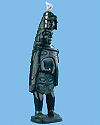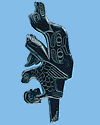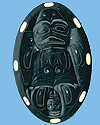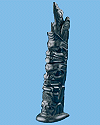Grand Hall tour
Inside the Haida House
House Partition Screen
House screens served to separate sleeping compartments of chiefs and other high-ranking families within the communal dwellings.
 The design on this screen, probably executed around 1850, shows at the
centre an ancestral figure -- Raven in human form -- with legs encircling
a round doorway. Raven also appears at the top and down the sides. The
figures are difficult to identify because their body parts have been
rearranged. This screen depicts the duality of two opposites, in this
case Whale and Raven, that come together to form a whole.
The design on this screen, probably executed around 1850, shows at the
centre an ancestral figure -- Raven in human form -- with legs encircling
a round doorway. Raven also appears at the top and down the sides. The
figures are difficult to identify because their body parts have been
rearranged. This screen depicts the duality of two opposites, in this
case Whale and Raven, that come together to form a whole.
The screen is carved and painted with red, green and black
pigments native to the area. It once belonged to an Eagle chief of
the Kaigani Haida village of Howkan, southeast Alaska.
Argillite Carvings
In the 1820s, Haida artists began carving argillite sculptures for commercial purposes. Argillite is a unique type of black shale that is found on a mountain slope near Skidegate, on Haida Gwaii (the Queen Charlotte Islands). The carvings were sold primarily to fur traders, whalers, private collectors and museums. The sculptures reflect traditional themes, and depict chiefs, shamans, houses and totem poles; argillite was also used to make platters, bowls, pipes, and plaques featuring crest figures.
 |
 |
 |
 |
Charles Edenshaw and Charles Gladstone were famous nineteenth-century artists who worked in this medium. Contemporary artists Bill Reid and Robert Davidson have continued the tradition of producing elegant argillite sculptures.
Dance robes of "button blankets" have been used for more than a century; the designs are emblems of the dancer's family history. They were first made when wool blankets were introduced from Europe. Native women transformed blankets into ceremonial clothing by adding appliqué crest designs cut from different colours of wool, and outlining the shapes with buttons. Button blankets are still worn during feasts and public performances of song and dance.
 The making of button blankets has developed into an art form, and
contemporary Native fabric artists continue to create these beautiful
garments. This superb example, Raven Bringing Light to the World
was made in 1987 by Haida fabric artist Dorothy Grant.
The making of button blankets has developed into an art form, and
contemporary Native fabric artists continue to create these beautiful
garments. This superb example, Raven Bringing Light to the World
was made in 1987 by Haida fabric artist Dorothy Grant.
Donated by Dr. Margaret P. Hess of Calgary

